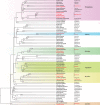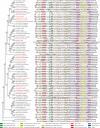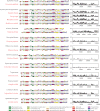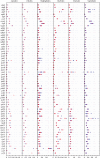Complete Chloroplast Genomes of 14 Mangroves: Phylogenetic and Comparative Genomic Analyses
- PMID: 32462024
- PMCID: PMC7225854
- DOI: 10.1155/2020/8731857
Complete Chloroplast Genomes of 14 Mangroves: Phylogenetic and Comparative Genomic Analyses
Abstract
Mangroves are a group of plant species that occupy the coastal intertidal zone and are major components of this ecologically important ecosystem. Mangroves belong to about twenty diverse families. Here, we sequenced and assembled chloroplast genomes of 14 mangrove species from eight families spanning five rosid orders and one asterid order: Fabales (Pongamia pinnata), Lamiales (Avicennia marina), Malpighiales (Excoecaria agallocha, Bruguiera sexangula, Kandelia obovata, Rhizophora stylosa, and Ceriops tagal), Malvales (Hibiscus tiliaceus, Heritiera littoralis, and Thespesia populnea), Myrtales (Laguncularia racemosa, Sonneratia ovata, and Pemphis acidula), and Sapindales (Xylocarpus moluccensis). These chloroplast genomes range from 149 kb to 168 kb in length. A conserved structure of two inverted repeats (IRa and IRb, ~25.8 kb), one large single-copy region (LSC, ~89.0 kb), and one short single-copy region (SSC, ~18.9 kb) as well as ~130 genes (85 protein-coding, 37 tRNAs, and 8 rRNAs) was observed. We found the lowest divergence in the IR regions among the four regions. We also identified simple sequence repeats (SSRs), which were found to be variable in numbers. Most chloroplast genes are highly conserved, with only four genes under positive selection or relaxed pressure. Combined with publicly available chloroplast genomes, we carried out phylogenetic analysis and confirmed the previously reported phylogeny within rosids, including the positioning of obscure families in Malpighiales. Our study reports 14 mangrove chloroplast genomes and illustrates their genome features and evolution.
Copyright © 2020 Chengcheng Shi et al.
Conflict of interest statement
The authors declare no conflict of interest.
Figures





Similar articles
-
Chloroplast Genome Sequences and Comparative Analyses of Combretaceae Mangroves with Related Species.Biomed Res Int. 2020 Sep 29;2020:5867673. doi: 10.1155/2020/5867673. eCollection 2020. Biomed Res Int. 2020. PMID: 33062686 Free PMC article.
-
Complete chloroplast genome sequence of the mangrove species Kandelia obovata and comparative analyses with related species.PeerJ. 2019 Sep 20;7:e7713. doi: 10.7717/peerj.7713. eCollection 2019. PeerJ. 2019. PMID: 31579601 Free PMC article.
-
Complete chloroplast genome sequence of MD-2 pineapple and its comparative analysis among nine other plants from the subclass Commelinidae.BMC Plant Biol. 2015 Aug 12;15:196. doi: 10.1186/s12870-015-0587-1. BMC Plant Biol. 2015. PMID: 26264372 Free PMC article.
-
Interspecific variation and phylogenetic relationship between mangrove and non-mangrove species of a same family (Meliaceae)-insights from comparative analysis of complete chloroplast genome.PeerJ. 2023 Jun 26;11:e15527. doi: 10.7717/peerj.15527. eCollection 2023. PeerJ. 2023. PMID: 37397021 Free PMC article.
-
The complete chloroplast genome sequence of Citrus sinensis (L.) Osbeck var 'Ridge Pineapple': organization and phylogenetic relationships to other angiosperms.BMC Plant Biol. 2006 Sep 30;6:21. doi: 10.1186/1471-2229-6-21. BMC Plant Biol. 2006. PMID: 17010212 Free PMC article.
Cited by
-
Comparative Analysis and Phylogenetic Relationships of Ceriops Species (Rhizophoraceae) and Avicennia lanata (Acanthaceae): Insight into the Chloroplast Genome Evolution between Middle and Seaward Zones of Mangrove Forests.Biology (Basel). 2022 Feb 28;11(3):383. doi: 10.3390/biology11030383. Biology (Basel). 2022. PMID: 35336757 Free PMC article.
-
Complete chloroplast genome of a semi-mangrove plant Hibiscus tiliaceus (Malvaceae).Mitochondrial DNA B Resour. 2021 Jun 14;6(7):1904-1905. doi: 10.1080/23802359.2021.1935337. Mitochondrial DNA B Resour. 2021. PMID: 34179470 Free PMC article.
-
Comparative genomics and phylogenetic relationships of two endemic and endangered species (Handeliodendron bodinieri and Eurycorymbus cavaleriei) of two monotypic genera within Sapindales.BMC Genomics. 2022 Jan 6;23(1):27. doi: 10.1186/s12864-021-08259-w. BMC Genomics. 2022. PMID: 34991482 Free PMC article.
-
Comparative Chloroplast Genomes and Phylogenetic Relationships of True Mangrove Species Brownlowia tersa and Brownlowia argentata (Malvaceae).Curr Issues Mol Biol. 2025 Jan 23;47(2):74. doi: 10.3390/cimb47020074. Curr Issues Mol Biol. 2025. PMID: 39996795 Free PMC article.
-
Comparative chloroplast genome analyses of Amomum: insights into evolutionary history and species identification.BMC Plant Biol. 2022 Nov 9;22(1):520. doi: 10.1186/s12870-022-03898-x. BMC Plant Biol. 2022. PMID: 36352400 Free PMC article.
References
-
- Tomlinson P. B. The Botany of Mangroves. Cambridge University Press; 1986.
-
- Ball M. C. Ecophysiology of mangroves. Trees. 1988;2(3):129–142. doi: 10.1007/bf00196018. - DOI
MeSH terms
LinkOut - more resources
Full Text Sources

